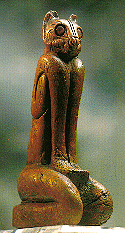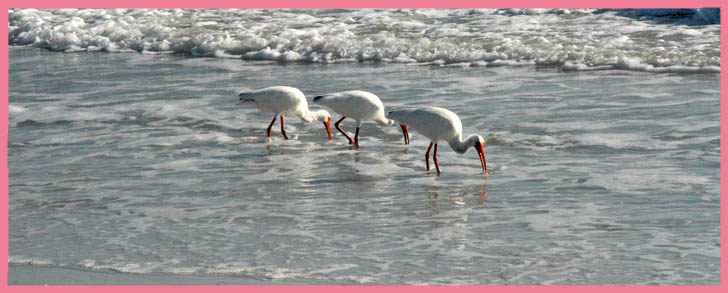|

|
|
Marco Island, Florida History
A BRIEF HISTORY OF MARCO
by Kathleen McNamara
Crossing the Jolley Bridge and looking out over immaculately clean and incredibly manicured Marco Island dotted on the far end with high-rise condominiums glistening in the bright sun, it's difficult to imagine what the scene would have looked like in earlier times.
Before the times of bridges, condominiums, marinas and expensive cars, Marco Island was divided into two different land masses; an area that is now the southernmost third of Marco and an area of about 50 acres of shell that had been raised by hand by Calusa Indians, who came to the Island at an unknown time and disappeared around the time of the Spanish Explorers. It was this northern tip that was named Key Marco and is now known as Olde Marco.
What is now the "center" of Marco Island was nonexistent. It was a water outlet into the Gulf of Mexico until it later became a mangrove swamp.
The Mysterious Calusa
What attracted a tribe of Paleo-Indians to Marco Island? That is a question that remains shrouded in mystery, as relatively little is known about this group of fishermen and skilled artisans who lived on Marco for perhaps more than a thousand years.
As tourists and residents of today, the Calusa were likely drawn to the island for its tropical, sheltered, almost mystical atmosphere. They were thought to have considered Marco a sacred place, as storm clouds rolling towards it often seemed to stop mysteriously and travel north or southward.
The Calusa were accomplished fishermen and artisans. They made brightly painted clay masks to resemble animals, they carefully wove fishing nets, they were known as fierce warriors and they wore jewelry and clothing - albeit very little in such a climate!
The Calusa also practiced an early form of recycling. They build giant mounds using clam shells, fish bones and other discarded items. The shell mounds located in what is today the Indian Hills area of the Estates are still today the highest area in Collier County. A new generation of twentieth century homes occupy the area.
It was believed that the plight of the Calusa was unfortunately similar to that of so many other Indian groups. European explorers such as Ponce de Leon, who may have died close to Marco after a battle with native people, brought disease and weapons with them. The result was decimation.
Captain Bill and The Cat
The arrival of homesteader Captain W.D. "Bill" Collier rang in the arrival of "civilized" life on Marco in 1870. Collier's Marco Island centered around the fishing and clamming industry. Captain Bill's relatives still live on Marco Island today.. Three of the original building of Collier's sleepy village still remain in the Olde Marco area today and receive more activity than they did in Collier's time. They now are all popular restaurants!
Captain Bill stumbled upon one of the richest archeological finds in Florida accidentally while he dug mucky soil as fertilizer for his garden. After word got around and the Smithsonian Institute archaeologist Frank Hamilton Cushing got involved in the excavation, which later became known as the widely celebrated "1896 Expedition",hundreds of artifacts were uncovered. Unfortunately, many of the items were lost days, sometimes hours, after being exposed to the air outside their mud burial site
One six-inch wooden brown-red cat statue did, however, survive. The Key Marco Cat, as it was later dubbed and is still called, became the very symbol of the lost Calusa and remains so today.
From November 1995 to May 1996, the feline made a special centenary appearance at the Collier County Museum. On loan from the Smithsonian reserves, it struck wonderment into the minds of thousands of visitors.
Three of the original building of Collier's sleepy village still remain in the Olde Marco area today and receive more activity than they did in Collier's time. They now are all popular restaurants!
Captain Bill stumbled upon one of the richest archeological finds in Florida accidentally while he dug mucky soil as fertilizer for his garden. After word got around and the Smithsonian Institute archaeologist Frank Hamilton Cushing got involved in the excavation, which later became known as the widely celebrated "1896 Expedition",hundreds of artifacts were uncovered. Unfortunately, many of the items were lost days, sometimes hours, after being exposed to the air outside their mud burial site
One six-inch wooden brown-red cat statue did, however, survive. The Key Marco Cat, as it was later dubbed and is still called, became the very symbol of the lost Calusa and remains so today.
From November 1995 to May 1996, the feline made a special centenary appearance at the Collier County Museum. On loan from the Smithsonian reserves, it struck wonderment into the minds of thousands of visitors.
Barron Collier's Dashed Dream
Barron Collier, a wealthy Northerner, inventor and generally well-respected forefather of the county that today shares his name, had a grand vision for Marco Island. However, he never quite realized his wish to develop and "vacationize" Marco, as he was unable to buy out Captain Bill and have complete control of the island. The depression of the 1930's certainly didn't help matters either. The failure of Barron Collier's Marco vision set the fateful stage for other broken dreams and land squabbles.
Deltona Days
The isolated, mosquito-infested and largely undeveloped little island remained so up until the early 1960's when Barron collier's last holdings were sold to Deltona Development Corporation with brothers Elliott, Robert and Frank Mackle at the helm.
The rich and famous as well as the blue collar were drawn to the "Hawaii of the East" by an incredibly successful marketing campaign. A beach-front hotel lured guests onto the sandy, clean and pristine beaches of Marco. Affordable subdivision-like housing was bought by those wishing to own a piece of paradise on the island's eastern shore, which was soon connected to land by a bridge. Many of these original homes are still occupied today by Islanders.
The Army Corps of Engineers, who had briefly held a post on the southern tip of the island during the 1950's at a missile tracking station, became embroiled in a lawsuit with the Mackle brothers when Deltona mapped out its development plans to include lands the government had deemed "environmentally sensitive."
After years of expensive court battles, the Mackles admitted defeat, but Marco Island would forever e indelibly etched in the minds of many as the ultimate vacation and living atmosphere.
Today and Tomorrow
Today it is a well established fact that Marco Island is a first-class resort island with a unique atmosphere that simply can't be found elsewhere. Where else would one find millionaires sitting among fishermen at chickee bars drinking and talking about the incredible fishing that can be had any time of the year?
Widespread development has brought multimillion dollar homes and condominiums, four-star resort hotel complexes, stores catering to all tastes and styles and a truly delightful assortment of restaurants. It has also brought a yearly influx of seasonal visitors who long to "run to the sun" when northern winters bring the chills.
Some would argue that development has brought congestion, noise and inevitable environmental destruction. But Marco Islanders, like the citizens of any precious community, take pride in their island. Various organizations have gotten involved in Marco's development - and it's only about 48 percent developed at present. Islanders are watchdogs, becoming politically active in an attempt to preserve the little Florida island history has shaped into a true paradise.
|
|
|
|

